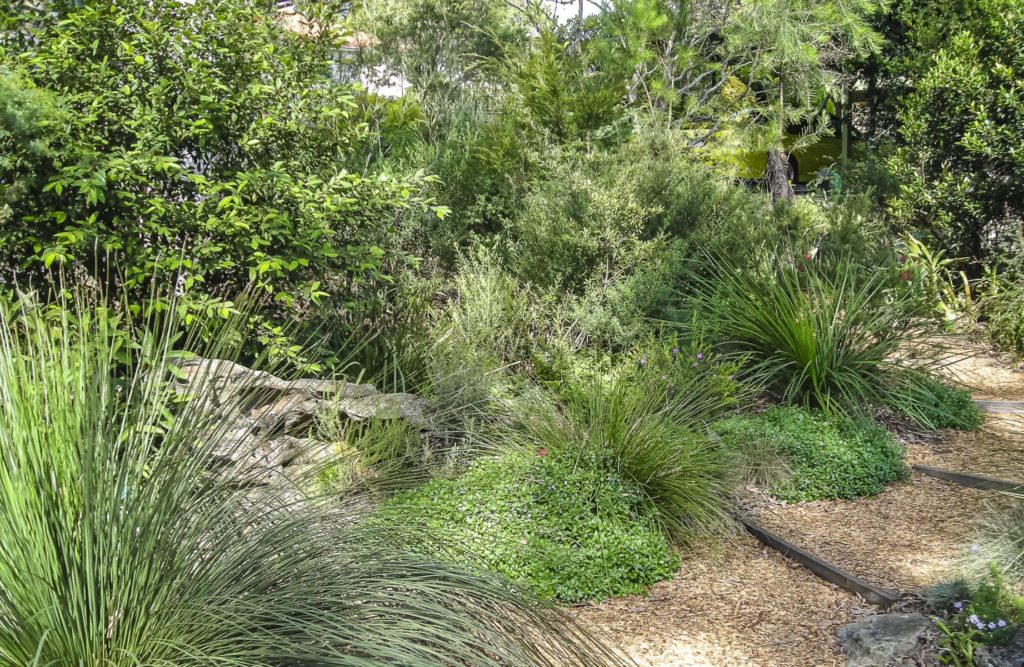This story by Mark Abell appeared in the APS Hunter Valley Group April 2020 newsletter.
What is a mulch?

A mulch is any covering put over the top of the soil, such as bark, woodchips, leaves, gravel and groundcovers – even a layer of leaf litter counts as a mulch.
There are a number of different types of materials that are widely used as mulches. These fall into two main categories:
- organic mulches, which do break down over time and thus will need to be periodically reapplied. They include things like pine bark, wood chips, leaves, grass clippings, straw, and even groundcover plants.
- inorganic mulches, which do not readily break down, but can become untidy when leaves fall on them. They include things like gravel, scoria, pavers and weed mats.
Why use them?
Mulches can help to save water, suppress weeds, moderate the soil temperature, and add nutrients and organic matter to the soil. They can also be used for decorative purposes.
How mulches work
Moderate the soil temperature – By both shading the soil surface and in providing an insulating layer, mulches can provide a more constant soil temperature. This in turn can protect the surface feeder roots from damage and reduces the evaporation from the surface of the soil.
Water saving – Mulches can help to save water by reducing evaporation from the soil surface. This provides an insulating layer of still air that reduces the rate of water loss.
Weed suppression – Mulches can inhibit the germination and growth of many weeds. Many weeds require light to stimulate germination, so shading of the soil surface by mulches restricts weed germination. Many mulches can also provide a physical barrier that weeds may find difficult to grow through.
Soil conditioning – Mulches can add nutrients and organic matter to the soil as they breakdown. This is applicable to organic mulches only.
Erosion control – Mulches can slow the flow of water over the surface of the soil. This not only helps with water absorption, it can help to reduce erosion of the soil surface.
Some caveats
Mulches can absorb water – To get to the soil, any water applied to the top of the mulch needs to pass through the mulch layer. This will absorb some of the applied water. The amount that is absorbed by the mulch is largely based on surface area of the mulch pieces and its composition, so a thick layer of fine mulch can absorb up to 20 mm of rainfall.
Nitrogen drawdown – Organic mulches can take nitrogen from the soil surface as they break down. This can be countered by applying an appropriate fertiliser. The nitrogen is eventually released back as the mulch completes its break down.
Plant transpiration – While mulches can reduce water loss from the soil, it should be remembered that the plants still transpire and use water. In beds with larger, more mature plants the relative water saving from mulches will be much less than from garden beds with small plants.
Collar rot – This can occur when mulches are placed up to the trunk of plants. The mulch can increase the humidity around the trunk which can lead to fungal infection. It is most prevalent where there are deeper layers of fine mulch. It can be easily controlled by ensuring that there is a gap between the mulch and the plant trunk.
Putting it all together
For water saving:
- Use coarser mulches rather than fine – as they absorb less water.
- Use a 2–6 cm layer, which is enough to get the benefits, but any deeper and it absorbs more water.
- Place any drip irrigation underneath the mulch layer.
- Avoid finer mulches for water saving, as too deep a layer affects water absorbing mulches.
For weed suppression, a thicker layer of finer mulch may work better.
For soil conditioning, composts, straws and lucerne hay are all good, as they do break down quickly.
References: Chapter 9 – Good Gardens with Less Water – Kevin Handreck (CSIRO Publishing), http://anpsa.org.au/design/gdnews24.html
